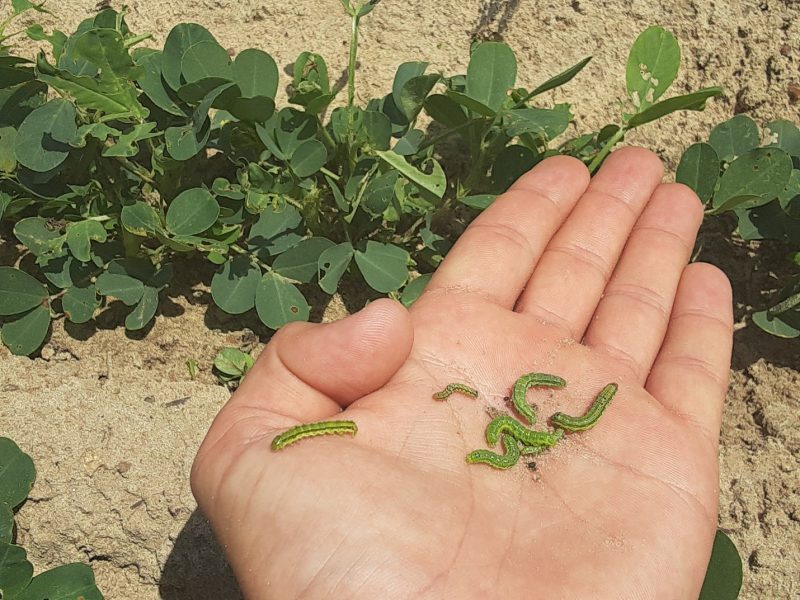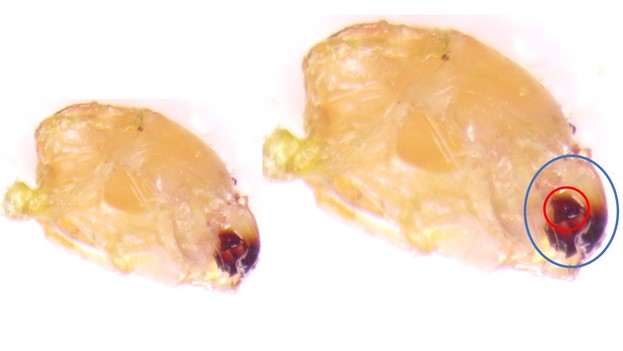By: Ethan Carter, UF/IFAS Regional Row Crop IPM Agent and Dr. Mark Abney, UGA Peanut Entomologist
Caterpillar sightings in young peanut fields have skyrocketed over the past week, with calls pouring into local extension offices. Some fields as young as 25 days after planting are exhibiting feeding injury from green and black caterpillars (Figure 1). Many of these field populations are being identified as the more expensive to control tobacco budworm.

Figure 1. Caterpillars found in 25-day old peanut in Jackson County. Photo by Ethan Carter, UF/IFAS.
–
The recommended peanut threshold for caterpillars is 4 to 8 per row foot, but in very young peanuts that is not always applicable. It is important to scout fields and know which species are present, and if populations are high enough to warrant treatment. Some caterpillars are easy to identify and control. A common practice for growers is to put 2-4 ounces of Dimilin in the tank with fungicide applications to clean up velvetbean caterpillars in the field. However, for the tobacco budworm caterpillars shown above in Figure 1, Dimilin will not be effective. Identification is key to controlling tobacco budworm effectively.
–
Corn earworm and tobacco budworm caterpillars look extremely similar but vary greatly in their susceptibility to insecticides.
- Corn earworms are generally controlled by pyrethroids, but this class of insecticide will not kill tobacco budworms. Fortunately, the products that are effective for tobacco budworm control will also work on corn earworm.
– - Tobacco Budworms are more difficult to control, and the products associated with them tend to be more expensive (product active ingredients include chlorantraniliprole, spinetoram, and spinosad). Reference a production guide or contact your local extension agent for product specifics.
_
The corn earworm and tobacco budworm can be identified by dissecting the head and examining the chewing mouthparts (mandibles). Tobacco budworm caterpillars have a small, dark tooth-like structure on the inside surface of the mandible. This “tooth” is not present in corn earworms. The mandibles can be examined by removing the head and splitting it lengthwise down the middle. A microscope or hand lens may be necessary to determine the presence of the tooth, though it can be seen with the naked eye, especially in larger caterpillars and by trained people with excellent eyesight (Figure 2).

Figure 2. Enlarged image of the cross section (half) of a tobacco budworm head. On the left is the original image, on the right a blue circle outlines the insect’s mandible, while the red circle shows the presence of a tooth within that mouthpart (signifying this is a budworm). Identification confirmation provided by Dr. Mark Abney, UGA Peanut Extension Entomologist.
–
Please contact your local extension office for specific questions regarding tobacco budworm identification and control options.
–
Videos on scouting for and identifying tobacco budworms
The following video was produced by Mark Abney, UGA Peanut Extension Entomologist to show how to scout peanuts for foliage feeding caterpillars.
–
The following is a very nice video from North Carolina State University further detailing the similarities and differences between corn earworms and tobacco budworms.
- Provisional Nitrogen Fertilization Recommendation for Florida Cotton for the 2025 Season - June 20, 2025
- NFREC-Quincy Row Crop Field Day – July 21 - June 20, 2025
- NFREC-Marianna Peanut Field Day – August 14 - June 20, 2025
